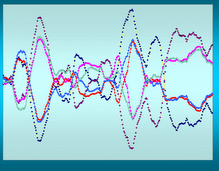Question 1 - Do you find the Pivot Points contained in Quotetracker to be useless relative to stocks whose opening price gaps-up? Short answer - no - I've used pivot points for a number of years (although I've gotten better with them in the past year than I was before - practice practice practice) and have no issues with the ones generated by Quote Tracker even on a gap-up stock. There are two ways to play gap-ups with pivots - first - wait for the stock to return to the pivot point (i.e. close the gap) and play from there on the rebound or second - play between R1 and R2 or mid-point high (which you can estimate using the EMA 4 or 8). If a stock gaps much beyond R2 I generally don't play it because I've learned that most of those have already blown it for the day.
Question 2 - Have you ever tried Camarilla Pivots? Are they any better/worse than normal pivots? My quick answer was I hadn't but I would look into them. The two figures below show some of the variances using a real trade that I took this morning.
I was out at the open at an appointment and didn't get back to the screens until about 11 A.M. I got my initial screens set-up and the NFI chart came up because I was using it to demonstrate something for Dogwood. I noticed that the price was coming back to the pivot point (I had it on a 4-minute frequency - I changed it to make it less cluttered for this demo). I said to myself - if it bounces off the pivot I'll take a trade - it did and I did. A little before 1 P.M. I closed the trade - right after it went over the R1.

Ordinarily I wouldn't have taken this trade except that it was there and I didn't have anything else set-up at the time. As it turns out I didn't have to sell it off when I did - it went back up through R3 and in fact I expected it too - but I had planned to sell it at that time and so I took the profit and ran. So that's a good example of how to play the pivots on a gap-up. You wait till it hits resistance and comes back. As far as gap-ups coming back - they don't always do they just mostly do. We call those Return to 4 or Return to 8. This one went a bit farther than that but you can see that the EMAs 4 and 8 are both about mid-way between pivot and R1. Imagine that - I don't make this stuff up folks - I really trade.
Here is how this trade looks using Camarilla pivots.

You can see the variances - first the pivot point is exactly the same - but H3 is just 4 cents away (on this chart - sometimes you can't even find it). But the variance between pivot point and H4 is closer than the normal pivot point and R1. I find that consistently from chart to chart and I don't like it. Here is why - most traders who are using pivot points are using the same old fashioned sets that I am - therefore they are watching the same old targets that I am. You should too - that's where the action is.
Now it could be that Quote Tracker doesn't have a correct formula for converting to Camarilla pivots but I doubt that. Either way I think I'm going to stick with what I know and understand - it seems to work - don't you think?
Thanks to Habben - he gave me a reference to Woodies club - and I guess the inventor of Woodies pivots is now making a living teaching others to trade - and that's good for him.
